Developing a video game can take anywhere from a few months to several years, depending on the project’s complexity. Beyond just coding, game development involves art design, sound creation, storytelling, and project management. With the gaming industry projected to surpass $200 billion by 2023, it’s a thriving field full of opportunities.
Whether you’re a seasoned developer or a beginner, this guide of stages of game development will walk you through the game development process, breaking down each stage to help you create your own game successfully.
How to Build a Game from Scratch?
The game development journey begins with a concept. You need to define the game’s objectives, mechanics, and overall design. Once the idea is clear, the game development stages move into pre-production, where the game’s visual elements, characters, and core features are planned in detail.
Next comes production, the most intensive phase. Here, developers create game assets, write code, and implement mechanics to bring the game to life.
Finally, the stages of video game development enters post-production, which focuses on testing, refining, and fixing bugs to ensure a smooth public launch.
2D vs. 3D: Which Game Style Suits Best?
Discover the key differences between 2D and 3D game development and how each shapes the player experience. Find out which one is the right fit for your next project!
Hire Expert
What Are the Stages of Game Development?
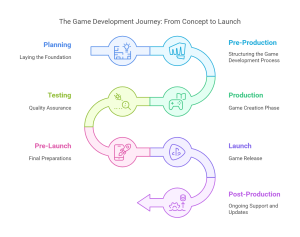
Game development process that takes an idea from concept to completion. This journey typically consists of seven key stages, each playing a specific role in shaping the final product. Below is an overview of the core phases:
- Planning
- Pre-Production
- Production
- Testing
- Pre-Launch
- Launch
- Post-Production
1. Planning: Laying the Foundation
The planning is one of the most important video game development stages where everything begins. At this stage, the development team defines the core concept of the game, establishes a clear vision, identifies the target audience, and outlines the project scope, budget, and timeline. Effective planning ensures that everyone involved understands the game’s objectives and can work efficiently to bring the vision to life.
This stage often starts with brainstorming sessions, where developers explore different ideas and find the best way to implement them while keeping costs and efficiency in mind. The team also conducts market research, analyzing industry trends, competitor games, and player preferences to ensure the concept has potential in the market.
Since ideas evolve rapidly in this stage, the initial concept may change significantly before moving forward. That’s why it’s crucial to finalize the core vision early—making major adjustments later can lead to costly setbacks.
The last step in the planning phase is creating a proof of concept, a basic outline that determines the resources needed and helps attract potential investors or publishers.
Here’s a table estimating the development time for different types of game development services:
Note: The timeline varies based on the game’s complexity and features.
2. Pre-Production: Structuring the Game Development Process
Pre-production is the foundation of game development steps. It is the phase where ideas take shape, core mechanics are defined, and the blueprint for the entire project is created. Steps in game development determine the game’s direction, development timeline, and required resources. Without a solid pre-production phase, the later stages of development can become chaotic and inefficient.
The primary goals of pre-production include:
- Refining the game concept and mechanics
- Establishing the visual and artistic direction
- Determining technical requirements and selecting the game engine
- Creating a structured production plan with estimated timelines and costs
- Developing prototypes to test core gameplay elements
Pre-production typically takes up 15-25% of the total development time, depending on the scale of the project.
Key Aspects of Pre-Production
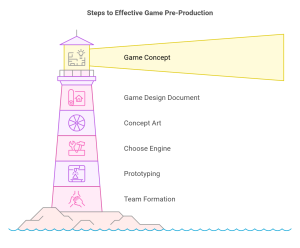
1. Game Concept Development: Defining the Core Vision
At the heart of every game is its concept, what the game is about, how it plays, and what makes it unique. This stage involves:
- Genre Selection: Deciding whether the game will be a shooter, RPG, puzzle, strategy, or another genre.
- Story and World-Building: If the game has a narrative, the team develops its lore, setting, characters, and backstory.
- Core Mechanics: Establishing how the game will play—movement, combat, puzzles, AI behavior, and other interactions.
- Target Audience & Market Research: Identifying the ideal player base and analyzing competitors to determine what makes the game stand out.
The more defined the concept, the smoother the production phase will be.
2. Game Design Document (GDD): The Master Plan
The Game Design Document (GDD) is the most critical document created during pre-production. It acts as the project’s blueprint, ensuring every team member follows a unified vision. The GDD includes:
- Story and Narrative Elements: Game plot, main characters, and world details.
- Gameplay Mechanics: How the player interacts with the game, including controls, combat, progression, and rewards.
- Level & World Design: Maps, locations, level progression, and environment concepts.
- Technical Aspects: Game engine, software, and platform requirements.
- Art & Visual Style: Concept art, UI design, and graphical themes.
- Monetization Strategies: If applicable, details on in-game purchases, ads, or premium content.
Since development is an evolving process, the GDD is a living document—meaning it is frequently updated and refined throughout production.
3. Concept Art & Visual Design: Defining the Game’s Aesthetic
The artistic direction of a game is crucial for immersion and engagement. Concept artists and designers work together to create:
- Character Design: Sketches of main characters, NPCs, enemies, and their personalities.
- Environment & World-Building: Drafting landscapes, buildings, and interactive elements.
- User Interface (UI) & User Experience (UX): Crafting menu designs, health bars, inventory screens, and navigation layouts.
At this stage, rough sketches and mood boards are used to define the visual identity of the game before moving into detailed asset creation during production.
4. Choosing the Right Game Engine & Tools
Selecting the right game engine is important for the development workflow. The choice depends on factors such as game complexity, platform compatibility, and available resources.
Popular Game Engines:
- Unity: Ideal for 2D & 3D games, widely used in indie and mobile game development.
- Unreal Engine: Best for high-end graphics and AAA-level projects.
- Godot: Open: source and beginner-friendly, great for smaller projects.
- Custom Engines: Some studios develop their own engines tailored to specific needs.
In addition to the engine, developers select animation software, physics engines, and AI frameworks to bring the game to life.
5. Prototyping: Testing the Core Gameplay (Optional but Recommended)
Before full-scale production begins, developers often create prototypes to test the gameplay mechanics and feasibility of their ideas.
Why Prototyping is Important:
Ensures core mechanics are engaging and functional before investing resources.
Identifies potential technical challenges early on.
Allows for rapid iteration and improvement of gameplay elements.
Prototypes typically use placeholder assets (basic models, textures, and sounds) since the focus is on mechanics rather than visuals. If a prototype fails to meet expectations, the team can refine the concept before committing to full-scale production.
6. Team Formation & Resource Allocation
During pre-production, the development team begins to take shape. Depending on the project size, this may include:
- Producers: Oversee project management, budgeting, and marketing.
- Game Designers: Define gameplay mechanics, level design, and overall experience.
- Artists & Animators: Create concept art, character models, and environmental assets.
- Programmers: Develop the game’s engine, physics, and AI behavior.
- Sound Designers & Composers: Work on audio effects, music, and voiceovers.
Smaller teams may have members wearing multiple hats, while larger teams specialize in different areas.
Set Your Game Up for Success!
Ensure your mechanics, budget, tech stack, and marketing plan are rock solid before full development. A strong foundation leads to a smoother launch!
Hire Expert
Finalizing Pre-Production: Preparing for Full Development
Before moving to the game phases of game development, the development team conducts final reviews to ensure everything is in place.
- Approval of Core Mechanics & Prototypes: Are the gameplay mechanics solid and engaging?
- Completion of GDD: Does the document cover all critical aspects of development?
- Budget & Timeline Finalization: Are costs and schedules realistic?
- Tech Stack Confirmation: Are the right tools and engines selected?
- Initial Marketing & Monetization Plans: How will the game generate revenue?
Once these elements are confirmed, the project officially transitions into production, where the full development process begins.
3. Production:
The production phase is the longest and key stage of the game development process that brings the game to life. Game development phases are when all the planning, design, and prototyping come together to create a playable game. Developers, designers, artists, and audio engineers work collaboratively to implement mechanics, build environments, and refine features.
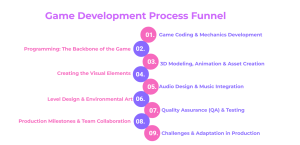
During production, the focus is on:
- Coding and implementing game mechanics
- Creating 2D/3D assets, animations, and environments
- Designing immersive soundscapes and voiceovers
- Developing and optimizing levels for a seamless experience
- Rigorous testing and debugging to ensure a polished final product
Production can take months or even years, depending on the scale and complexity of the game. This phase is where ideas are tested, refined, and sometimes even reworked to improve the gameplay experience.
-
Game Coding & Mechanics Development
Game coding and mechanics development includes different factors:
Programming: The Backbone of the Game
Programmers are responsible for writing the code that powers the game. They collaborate with designers and artists to ensure that gameplay mechanics function as intended. The primary areas of coding include:
Game Engine Programming: Developers use engines like Unity, Unreal Engine, or custom-built engines to create the core functionality of the game.
Systems Development: This includes creating AI behavior, physics simulations, networking for multiplayer features, and UI interactions.
Optimization & Performance Tuning: Programmers work to ensure the game runs smoothly on various platforms, reducing load times and improving responsiveness.
There are two main types of developers in game programming:
- Engine Developers: Focus on building the interactive aspects of the game.
- Systems Developers: Handle backend operations, such as networking and performance optimization.
Due to the high demand for experienced programmers, software development remains one of the most lucrative careers, with senior developers earning over $127,000 per year as of 2024.
-
3D Modeling, Animation & Asset Creation
3D modeling, animation and asset creation is one of the important factor which depends on the visual elements the most.
Creating the Visual Elements
Artists and animators are responsible for bringing the game’s world to life through stunning visuals. The process involves:
- 3D Modeling: Using tools like Blender, Maya, or 3DS Max, artists create characters, objects, and environments by sculpting digital assets.
- Texture & Lighting: Artists apply materials and textures to models to enhance realism and style. Lighting effects are added to create mood and depth.
- Animation: Movement is created through keyframe animation or motion capture technology. Animators ensure smooth transitions and lifelike interactions.
To keep the game running efficiently, polygon counts are optimized to balance performance and visual quality. Effects like water, fire, and smoke are designed by FX artists using Houdini or other simulation software.
-
Audio Design & Music Integration
The Role of Sound in Gaming
Sound design plays a crucial role in enhancing player immersion. Sound engineers and composers work on:
- Sound Effects: Footsteps, gunshots, ambient noises, and UI sounds.
- Background Music: Dynamic soundtracks that change based on gameplay moments.
- Voice Acting: Recording and editing dialogue for characters and narration.
A well-designed audio experience adds emotional depth to a game. Studies show that 42% of Gen Z gamers listen to other music while gaming, while 34% look up and stream music from their favorite games. Many games, such as STALKER 2 and Hades, use adaptive music systems that adjust based on in-game actions.
-
Level Design & Environmental Art
Crafting Immersive Worlds
Level designers focus on creating engaging environments that align with the game’s story and mechanics. Their key responsibilities include:
- Map Layouts & Navigation: Ensuring levels are structured logically and encourage exploration.
- Balancing Challenges & Rewards: Providing players with a mix of obstacles, puzzles, and incentives to keep them engaged.
- Environmental Storytelling: Using visual cues like lighting, props, and architecture to enhance storytelling.
Game development engines like Unity and Unreal Engine help designers create interactive and visually appealing environments. Artists transform initial concept art into fully rendered 3D spaces, ensuring consistency with the game’s theme and style.
-
Quality Assurance (QA) & Testing
Ensuring a Smooth Gaming Experience
No game is complete without thorough testing. QA testers play a vital role in identifying and reporting bugs, glitches, and gameplay issues.
Types of Game Testing:
- Functionality Testing – Ensuring all mechanics work as expected.
- Performance Testing – Checking frame rates, load times, and hardware compatibility.
- User Experience (UX) Testing – Evaluating controls, interface, and accessibility.
QA testers go through levels repeatedly to push the game’s boundaries, finding issues for developers to fix before launch.
-
Production Milestones & Team Collaboration
Keeping Development on Track
Since game development is a time-consuming process, teams break production into milestones to manage progress efficiently. These checkpoints include:
- Prototype Completion: Basic gameplay mechanics are finalized.
- Alpha Version: A playable version of the game with core systems in place.
- Beta Version: Refinements are made, and user testing begins.
- Final Build: The game is optimized and prepared for release.
Effective communication and teamwork are essential in this phase. Without proper collaboration, errors may occur, leading to costly reworks and delays.
-
Challenges & Adaptation in Production
Game development is rarely a straightforward process. Changes and revisions are common, and some features may need to be adjusted or even removed.
Example: In Spyro the Dragon, the Balloonist character was originally a Viking Boatman. However, since the Dream Weavers world was floating in the sky, the design was changed to fit the environment better.
Another Case: In The Simpsons: Hit & Run, developers had to cut entire levels and house interiors to meet deadlines and maintain quality.
These adjustments ensure the final product is polished and engaging while staying within production constraints.
4- Testing:
Testing is the final quality check, quality assurance (QA) is often considered part of the production phase, but its significance is so great that it deserves its own discussion.
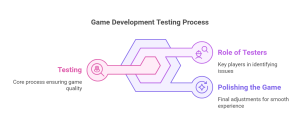
One of the biggest misconceptions in game development is underestimating the testing phase. The development process is always under tight deadlines, and each project prioritizes tasks differently. With pressure to launch the game as soon as possible, testing is often rushed or even skipped. However, this can have disastrous consequences once the game is released.
The Role of Testers in Game Development
While testing does not create new content, it ensures that everything works as intended. Testers thoroughly examine:
- Accessibility of all areas in the game
- Proper display of UI elements from different angles
- Correct functionality of all features
To cover different aspects of the game, testing teams are often divided into specialized groups:
Stress Testers:
Push the game’s limits to check if it can handle extreme conditions (e.g., maximum players, high-speed actions).
Walkthrough Testers
Complete a 100% playthrough, including all achievements and hidden elements, to verify everything functions correctly.
Engagement Testers
Assess the game’s fun factor, difficulty balance, and ability to retain players over time.
If issues are found, the game is sent back for adjustments. This cycle repeats until the testers confirm it is ready for launch. Think of testers as the last line of defense before the game reaches players.
Polishing the Game for a Smoother Experience
Polishing is an ongoing process throughout development. It ensures the game runs smoothly without bugs, performance issues, or stuttering.
Key Areas of Polishing:
- Bug Fixing: Identifying and resolving errors before release.
- Performance Optimization: Ensuring smooth gameplay across different devices.
- Gameplay Refinement: Balancing mechanics to enhance the player experience.
For AAA games, polishing is a dedicated, well-funded step. Smaller indie games may allocate fewer resources due to budget constraints.
5- Pre-Launch
Pre-launch is something preparing for a Successful Game Release. The pre-launch phase is a crucial step in game development, where the focus shifts from creation to promotion, final testing, and distribution. This stage is all about building anticipation and ensuring the game is polished before its official release
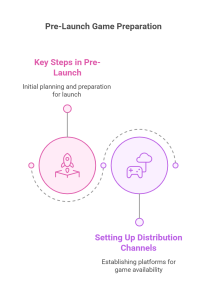
Key Steps in Pre-Launch
Following are the key steps included in pre-launch:
Marketing & Promotion
Now is the time to generate hype and excitement. Developers can promote their game through:
- Trailers & Teasers: Showcase gameplay, story, and visuals to attract players.
- Demos & Early Access: Let players try a portion of the game to build interest.
- Events & Conventions: Reveal the game at major gaming events like E3, PAX, or Nintendo Direct.
- Influencer & Community Engagement: Partner with YouTubers, streamers, and gaming communities to reach a wider audience.
Final Testing & Bug Fixing
As the game nears launch, one last round of testing is conducted to catch any remaining bugs or performance issues. The development team works hard to fix critical problems and ensure the game is stable and optimized before it reaches players.
Setting Up Distribution Channels
Developers finalize how the game will be distributed:
- Digital Stores – Platforms like Steam, PlayStation Store, Xbox Store, and Nintendo eShop.
- Physical Copies – Retail partnerships for boxed editions.
- Mobile Platforms – Google Play and Apple App Store for mobile releases.
This phase is exciting yet uncertain, as player reactions are unpredictable. Handling criticism well can lead to success. Bloodstained: Ritual of the Night faced backlash for poor visuals, but by addressing feedback and improving graphics, the developers turned it into a highly praised game.
6- Launch
The launch of a game is its most critical moment, marking its availability to players worldwide. Even at this stage, developers may make final refinements to visuals, animations, and gameplay elements to ensure a polished experience. A smooth release requires careful planning, from testing stability to generating excitement through marketing and events.
However, a successful launch isn’t guaranteed—many games have suffered from bugs and technical issues, damaging their reputation despite later fixes. To avoid this, studios focus on last-minute bug fixes, quality improvements, and final artistic touches while being cautious of last-minute changes that could introduce new problems. A well-executed launch sets the stage for a game’s long-term success.
7- Post-Production
Releasing a game is a huge milestone, but the work doesn’t stop there. The post-launch phase is crucial for maintaining a positive player experience, fixing unexpected issues, and keeping the game relevant in a competitive market.
Bug Fixes and Performance Updates
Even with thorough testing, some minor bugs may only become apparent after launch, especially on different hardware or operating systems. These issues don’t necessarily mean the testing team was ineffective; rather, they can be specific to certain devices or configurations. Developers rely on player feedback from forums, reviews, and direct reports to identify and address these bugs, releasing patches and updates to enhance stability and gameplay.
Adding New Content and Features
To keep players engaged and encourage them to return even after completing the game, developers often introduce additional content. This can include new levels, chapters, characters, multiplayer modes, or downloadable expansions (DLCs). In competitive gaming, regular updates and new features help maintain a strong player base and ensure the game remains relevant for as long as possible.
Post-Mortem and Future Planning
After launch, many studios conduct a post-mortem, a detailed review of what worked well and what could be improved. This helps developers refine their process for future projects, making production more efficient and avoiding past mistakes. Large franchises, like Call of Duty and sports game series, frequently reuse assets, mechanics, and code from previous titles to streamline development and maintain consistency across sequels.
However, a well-supported game fosters a loyal community, improves player satisfaction, and extends its lifespan in the gaming market. Timely bug fixes, performance improvements, and engaging new content can turn an average launch into a long-term success. In today’s gaming industry, post-launch support is just as important as the initial development process, ensuring the game remains polished, enjoyable, and competitive for years to come.
Turn Your Game Idea Into Reality!
Game development requires strategy, teamwork, and innovation. From planning to launch, we help you navigate every stage—ensuring a polished, market-ready game. Let’s build something amazing together!
Hire Expert
Wrap Up:
Game development is a complex yet exciting journey that requires the best stages of game development which includes careful planning, teamwork, and expertise. Each project is unique, shaped by client needs and evolving technology, making adaptability and innovation key to success. A clear vision, a skilled team, and thorough testing are essential to ensure a polished final product. Additionally, pre-launch marketing plays a crucial role in reaching the right audience and maximizing a game’s potential. As the industry evolves, advancements in blockchain, virtual reality, and augmented reality are shaping the future of gaming. With the right strategy and execution, any great idea can turn into an outstanding game. If you’re ready to bring your vision to life, contact us today.
















